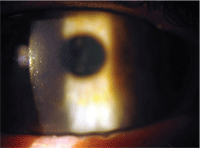 As eye care providers, we are frequently asked about makeup application and removal. Many of us think about ocular health effects, such as the need to keep the meibomian glands clean, but we seldom think about the impact of makeup or removing agents on the contact lens itself.
As eye care providers, we are frequently asked about makeup application and removal. Many of us think about ocular health effects, such as the need to keep the meibomian glands clean, but we seldom think about the impact of makeup or removing agents on the contact lens itself.
At the 2011 Association for Research and Vision in Ophthalmology meeting, I had the pleasure of speaking to Junko Tsukiyama, M.D., Ph.D., a researcher from Hakujukai Yamamoto Hospital’s Department of Ophthalmology and the Kinki University School of Medicine in Japan. Dr. Tsukiyama and her colleagues are looking at the effects of cosmetics and associated cleaners on the contact lens matrix.
Recently published in the Journal of Japan Contact Lens Society, Dr. Tsukiyama cited the growing trend to wear waterproof cosmetics which contain oil-based or silicone-based film-forming agents that do not fade or wash off with tears of perspiration.1 These cosmetics often require an oil-based cleaner to effectively cleanse the lids.
Cleansing products and eye cosmetics often contain liquid paraffin (mineral oil), triglycerides, ester oil, silicone oil, high grade fatty acids and high grade alcohols. In addition, there are lipid components in the tear film that may interact with the lens surface. Dr. Tsukiyama hypothesized that these oil and silicone residues may indeed affect the contact lens matrix. It has long been established that silicone-based contact lenses are more lipophilic than conventional HEMA lenses and, therefore, may absorb cosmetics and cleaners that modify the lens.2-6

Oily deposits on a contact lens from eye makeup.
To test her hypotheses, Dr. Tsukiyama looked at silicone containing contact lenses and one HEMA based lens in separate studies. She applied either a mineral cleaning oil or an oil-containing eyeliner pencil to the surface of the lenses. She then followed a protocol of saline soaks and rubbing and rinsing with a MPS product and daily cleaners. After the cleaning protocol, she evaluated the lenses for deposition and deformation.
Dr. Tsukiyama observed no changes with the cleaning oil treatment on plasma polymer surface treated lenses (lotrafilcon A and B) or the HEMA lens (etafilcon A). Non-plasma treated lenses (senofilcon A, galyfilcon A, balafilcon A and asmofilcon A) showed deformation of the lens surface.1
In the case of eyeliner pencil only, it was only contamination. Deformation was observed in the case of cleansing oil.7 Dr. Tsukiyama suggested that this observation made sense given that previous studies have shown less lipid adsorption on plasma polymer treated lenses.3,4
While contaminants on the silicone hydrogel lens surface were easy to remove with a surfactant daily cleaner, oily contaminants were difficult to remove once the contact lens shape had been deformed. The lens shape could not be restored through the use of a daily cleaner.7
Whether patients apply makeup after the lenses are in or remove makeup before the lenses come off, it is common to get cosmetic products on the lens. Understanding how lenses react to products used in combination with lens wear—but not mandatorily tested with lenses (like MPS solutions or lubricant drops)—will further our understanding of patient comfort and safety. I look forward to further research from Dr. Tsukiyama’s lab.
1. Tsukiyama J, Miyamoto Y, Fukuda M, et al. Influence of eye cosmetics and cleansing products on contact lenses. J Jpn CL Soc. 2010:52:101-7.
2. Jones L, Senchyna M, Glasier MA, et al. Lysozyme and lipid deposit on silicone hydrogel contact lens materials. Eye Contact Lens. 2003 Jan;29 (1 Suppl):S75-9.
3. Carney FP, Nash WL, Sentell KB. The Absorption of major tear film lipids in vivo to various silicone hydrogels over time. Invest Ophthalmol Vis Sci. 2008 Jan;49(1):120-4.
4. Iwata M, Ohno S, Kawai T, et al. In vitro evaluation of lipid adsorbed on silicone hydrogel contact lenses using a new gas chromatography/mass spectrometry analytical method. Eye Contact Lens. 2008;34:272-80.
5. Bontempo AR, Rapp J. Lipid deposits on hydrophilic and rigid gas permeable contact lenses. CLAO J. 1994 Oct;20(4):242-5.
6. Cheung SW, Cho P, Chan B, et al. A comparative study of biweekly disposable contact lenses: silicone hydrogel versus hydrogel. Clin Exp Optom. 2007 Mar;90(2):124-31.
7. Tsukiyama J, Miyamoto Y, Fukuda M, et al. Contamination of Silicone Hydrogel Contact lenses by cosmetics and the cleaning effect of contact lens daily cleaners. Poster presented at the ARVO meeting, May 2011.


